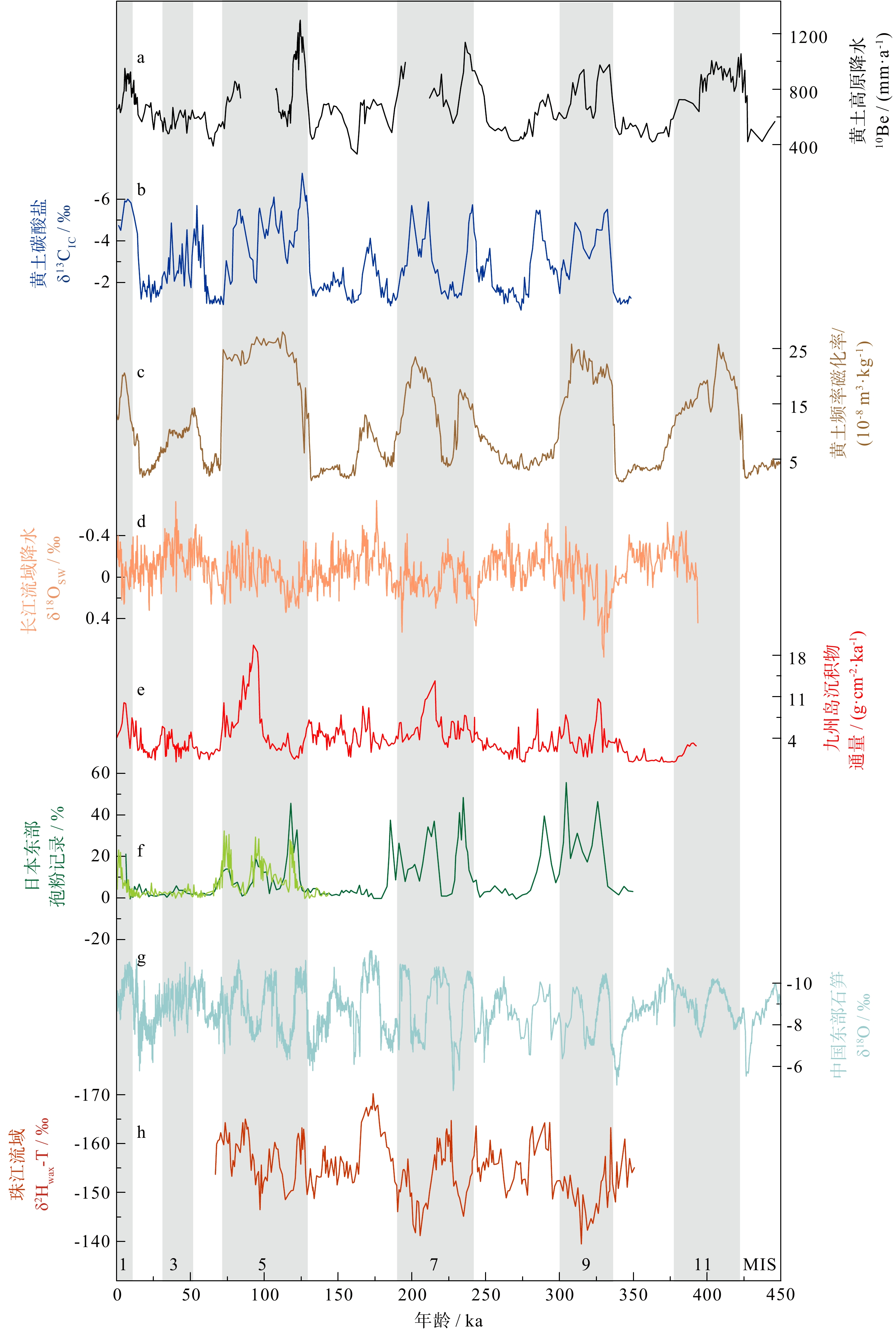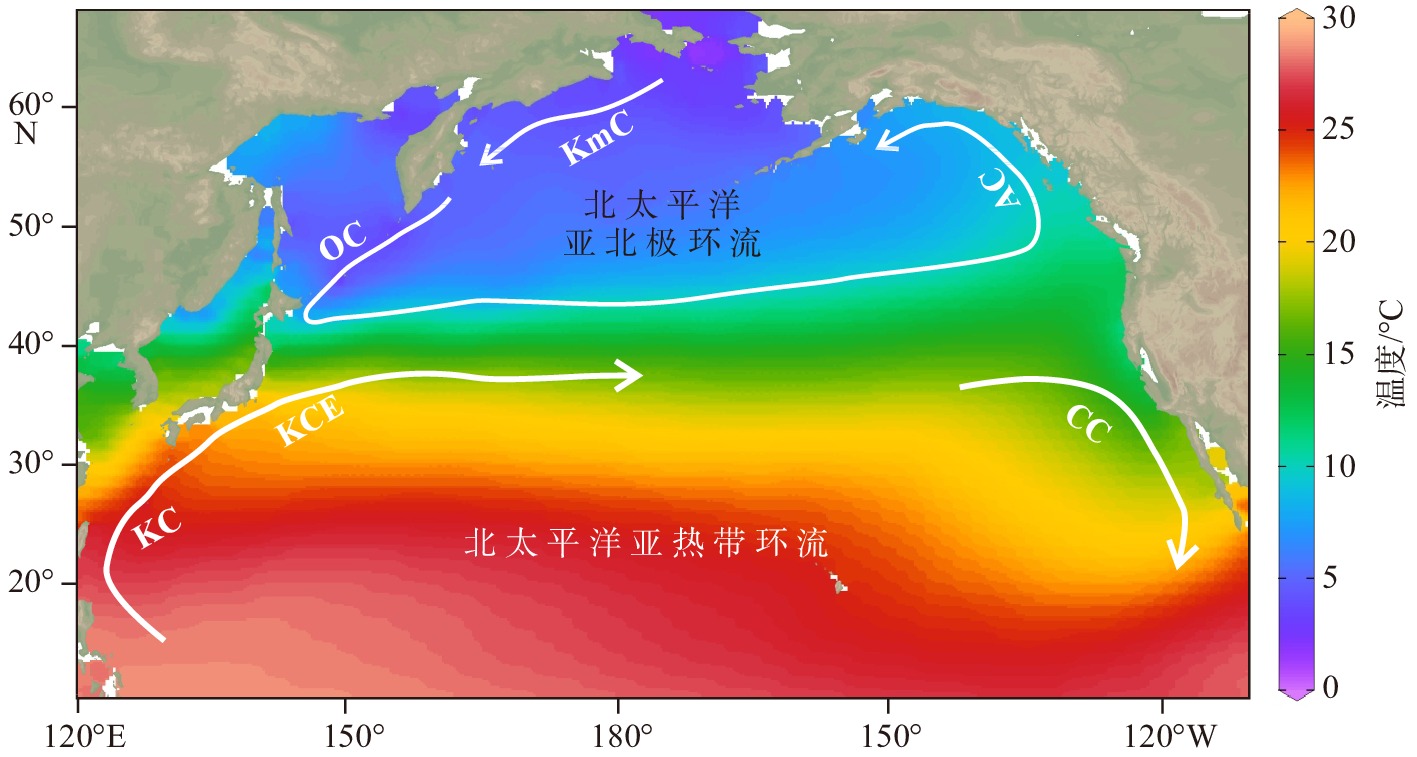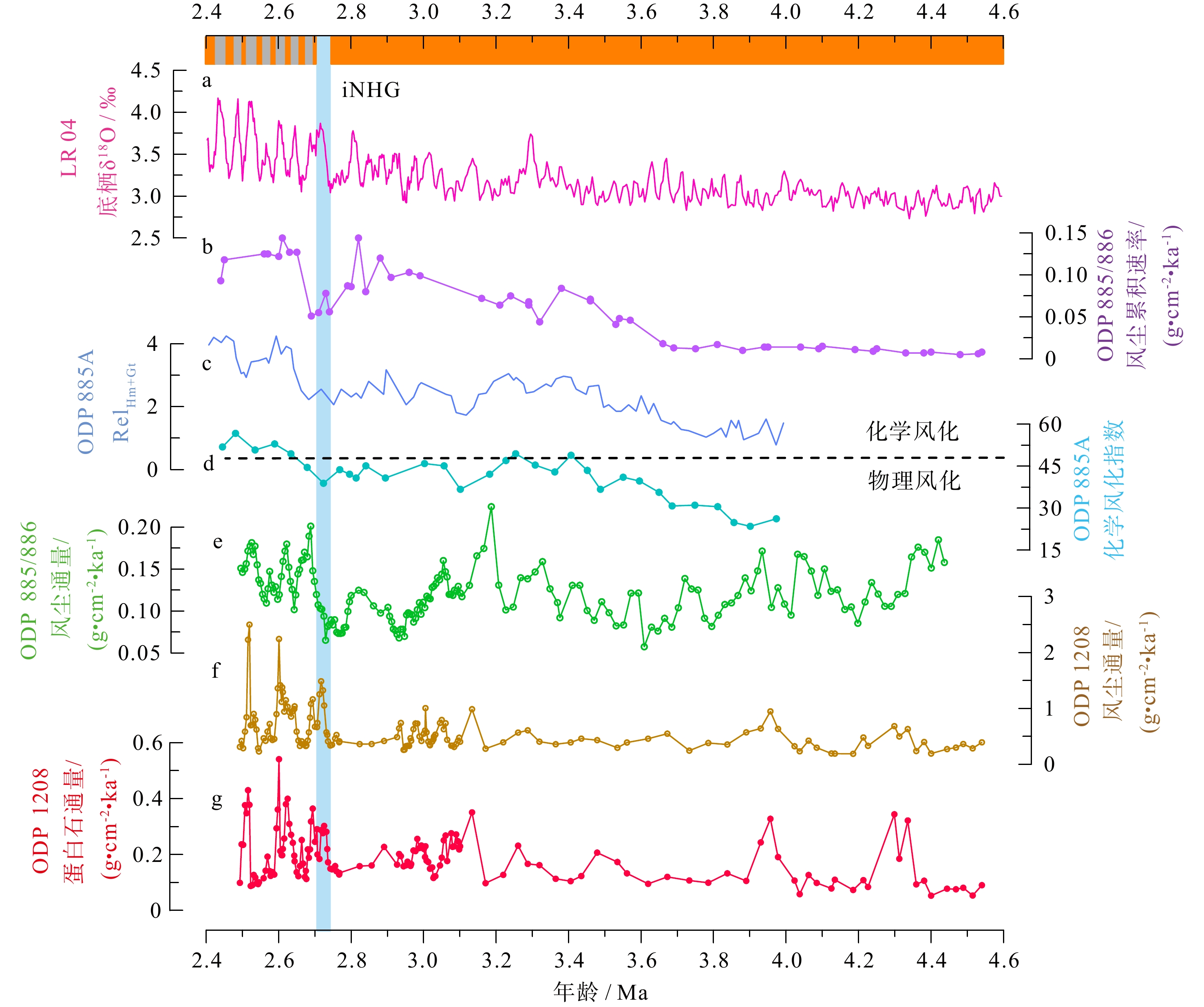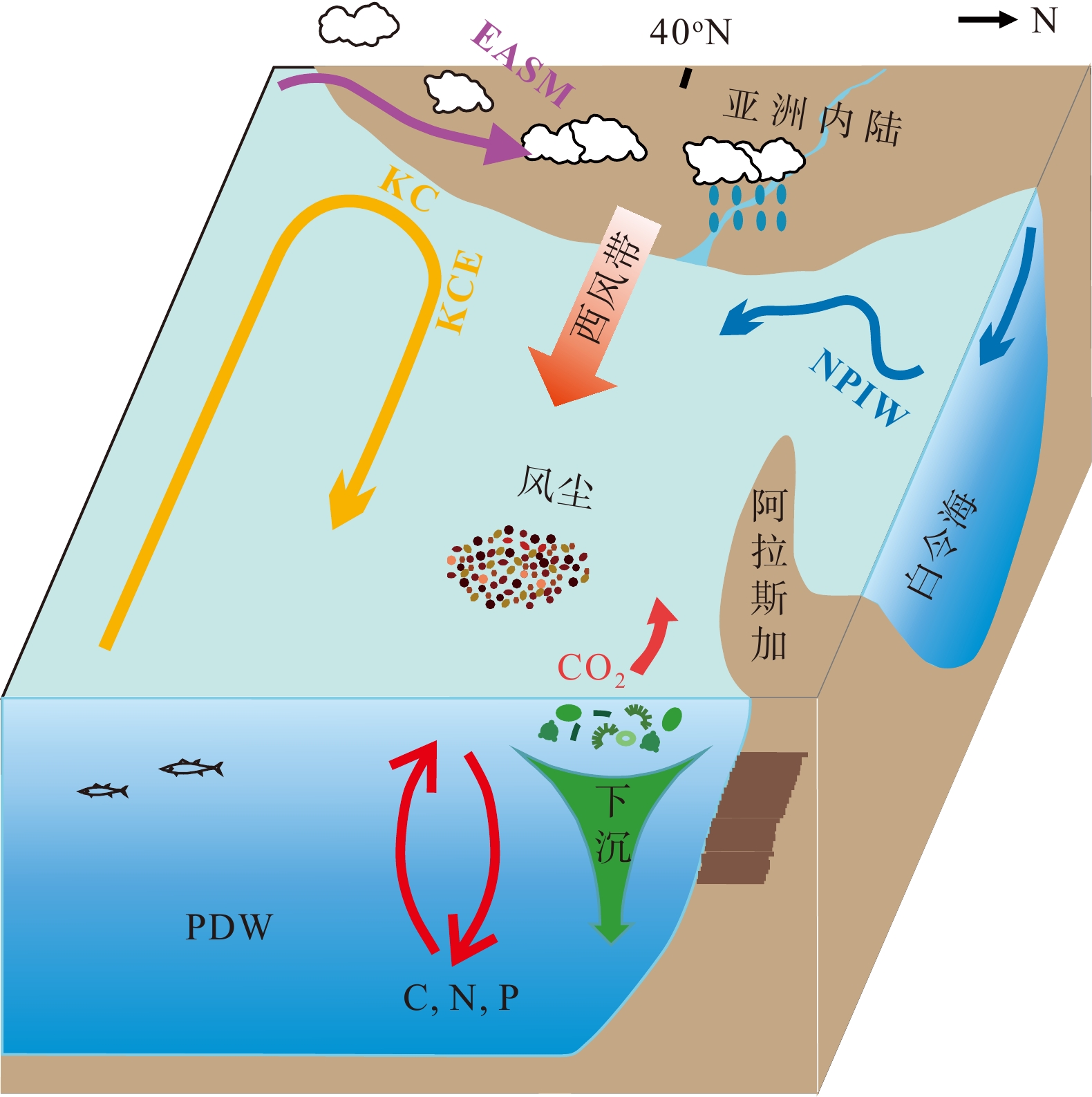Research progress of ocean drilling in the North Pacific Ocean: Paleoceanography and paleoclimate
-
摘要:
北太平洋作为全球大洋环流的重要组成部分,在高低纬间热量和物质的传输与再分配方面起到重要的调控作用,进而影响到地球气候系统。基于过去50多年来的大洋钻探工作,前人在北太平洋地球科学的研究上取得了一系列的成果。本文回顾了北太平洋古海洋和古气候方面的研究进展,包括:(1)东亚夏季风和西部边界流演化,以及其对高低纬热量、水汽的传输;(2) 北太平洋中层水和深层水的性质变化、分布范围和驱动机制,以及冰期旋回中水体垂直交换作用的气候响应;(3) 风尘输入对亚洲内陆古环境的反映,及其对北太平洋生产力的铁肥效应。尽管前人针对上述科学问题都开展了相应的研究工作,但目前在对北太平洋上述几方面的认识上仍然存在着分歧。基于对前人研究的总结概括,本文最后提出了未来北太平洋研究的关键科学问题,强调了多圈层、多系统角度对深入认识过去地球气候系统变化的重要性,并对未来大洋航次开展的理想靶区进行了展望。
Abstract:As an important part of global ocean circulation, the North Pacific Ocean plays a key role in regulating the transfer and redistribution of heat and matter between high and low latitudes, thus affecting the Earth’s climate system. Based on the ocean drilling programs over 50 years in the past, many achievements in geoscience have been made. We reviewed the progresses of paleoclimate research in the North Pacific in the following aspects: (1) the evolution of the East Asian summer monsoon and the western boundary current, as well as their contributions to the transportation of heat and water vapor between high and low latitudes in North Pacific; (2) changes in water property, distribution, and the driving mechanisms of the Pacific Deep Water and North Pacific Intermediate Water, as well as the climatic response of their interaction during glacial-interglacial cycles; (3) the response of aeolian flux to the Asian inland and its iron fertilization effect on the North Pacific productivity. Previous studies have addressed those scientific problems, uncertain issued remain controversial. We therefore proposed the key scientific issues for future research in the North Pacific Ocean, and emphasized the importance of multi-layer and multi-system perspectives for deciphering the past changes of the Earth's climate system. Finally, we suggested the ideal target areas for ocean drilling program in North Pacific in the future.
-
Key words:
- ocean drilling /
- East Asian summer monsoon /
- western boundary current /
- eolian dust /
- productivity /
- North Pacific
-

-
表 1 北太平洋古海洋与古气候大洋钻探航次
Table 1. The ocean drilling expeditions in the North Pacific
航次 钻探区域 主要研究目标 钻探站位 时间 Leg 86/88 西北太平洋 风尘、黑潮延伸流 576—581 1982 Leg 145 亚北极太平洋 风尘、NPIW 881—887 1993 Leg 198 沙莰基隆起 深水环流 1207—1214 2001 323 白令海 NPIW U1339—1345 2009 341 阿拉斯加大陆边缘 NPIW U1417—1421 2013 346 日本海 东亚季风 U1422—1430 2013 -
[1] Worne S, Kender S, Swann G E A, et al. Coupled climate and subarctic Pacific nutrient upwelling over the last 850, 000 years [J]. Earth and Planetary Science Letters, 2019, 522: 87-97. doi: 10.1016/j.jpgl.2019.06.028
[2] Jaccard S L, Haug G H, Sigman D M, et al. Glacial/interglacial changes in subarctic north pacific stratification [J]. Science, 2005, 308(5724): 1003-1006. doi: 10.1126/science.1108696
[3] Takahashi K, Ravelo A, Alvarez-Zarikian C. Pliocene-Pleistocene paleoceanography and climate history of the Bering Sea[R]. Scientific Prospectus, IODP, 323, 2009: 3-4,doi: 10.2204/iodp.sp.323.2009.
[4] Gray W R, Rae J W B, Wills R C J, et al. Deglacial upwelling, productivity and CO2 outgassing in the North Pacific Ocean [J]. Nature Geoscience, 2018, 11(5): 340-344. doi: 10.1038/s41561-018-0108-6
[5] Paulmier A, Ruiz-Pino D. Oxygen minimum zones (OMZs) in the modern ocean [J]. Progress in Oceanography, 2009, 80(3-4): 113-128. doi: 10.1016/j.pocean.2008.08.001
[6] Schmidtko S, Stramma L, Visbeck M. Decline in global oceanic oxygen content during the past five decades [J]. Nature, 2017, 542(7641): 335-339. doi: 10.1038/nature21399
[7] Deutsch C, Brix H, Ito T, et al. Climate-forced variability of ocean hypoxia [J]. Science, 2011, 333(6040): 336-339. doi: 10.1126/science.1202422
[8] Shao Y P, Wyrwoll K H, Chappell A, et al. Dust cycle: An emerging core theme in Earth system science [J]. Aeolian Research, 2011, 2(4): 181-204. doi: 10.1016/j.aeolia.2011.02.001
[9] Forster P, Ramaswamy V, Artaxo P, et al. Changes in atmospheric constituents and in radiative forcing[C]//Climate Change 2007: The Physical Science Basis. Contribution of Working Group I to the Fourth Assessment Report of the Intergovernmental Panel on Climate Change. Cambridge: Cambridge University Press, 2007: 129-234.
[10] Martin J H. Glacial-interglacial CO2 change: The iron hypothesis [J]. Paleoceanography, 1990, 5(1): 1-13. doi: 10.1029/PA005i001p00001
[11] Mitchell B G, Brody E A, Holm-Hansen O, et al. Light limitation of phytoplankton biomass and macronutrient utilization in the Southern Ocean [J]. Limnology and Oceanography, 1991, 36(8): 1662-1677. doi: 10.4319/lo.1991.36.8.1662
[12] Li D W, Zheng L W, Jaccard S L, et al. Millennial-scale ocean dynamics controlled export productivity in the subtropical North Pacific [J]. Geology, 2017, 45(7): 651-654. doi: 10.1130/G38981.1
[13] Lam P J, Robinson L F, Blusztajn J, et al. Transient stratification as the cause of the North Pacific productivity spike during deglaciation [J]. Nature Geoscience, 2013, 6(8): 622-626. doi: 10.1038/NGEO1873
[14] Schlitzer R. Ocean data view[EB/OL]. 2022(2022-04-04). https://odv.awi.de.
[15] Ogi M, Tachibana Y. Influence of the annual Arctic Oscillation on the negative correlation between Okhotsk Sea ice and Amur River discharge [J]. Geophysical Research Letters, 2006, 33(8): L08709. doi: 10.1029/2006GL025838
[16] Shcherbina A Y, Talley L D, Rudnick D L. Direct observations of North Pacific ventilation: Brine rejection in the Okhotsk Sea [J]. Science, 2003, 302(5652): 1952-1955. doi: 10.1126/science.1088692
[17] Emile-Geay J, Cane M A, Naik N, et al. Warren revisited: Atmospheric freshwater fluxes and "Why is no deep water formed in the North Pacific'' [J]. Journal of Geophysical Research:Oceans, 2003, 108(C6): 3178. doi: 10.1029/2001JC001058
[18] Wang P X, Wang B, Cheng H, et al. The global monsoon across time scales: Mechanisms and outstanding issues [J]. Earth-Science Reviews, 2017, 174: 84-121. doi: 10.1016/j.earscirev.2017.07.006
[19] Maher B A, Thompson R. Oxygen isotopes from Chinese caves: records not of monsoon rainfall but of circulation regime [J]. Journal of Quaternary Science, 2012, 27(6): 615-624. doi: 10.1002/jqs.2553
[20] Parker S E, Harrison S P, Comas-Bru L, et al. A data-model approach to interpreting speleothem oxygen isotope records from monsoon regions [J]. Climate of the Past, 2021, 17(3): 1119-1138. doi: 10.5194/cp-17-1119-2021
[21] Caley T, Roche D M, Renssen H. Orbital Asian summer monsoon dynamics revealed using an isotope-enabled global climate model [J]. Nature Communications, 2014, 5: 5371. doi: 10.1038/ncomms6371
[22] Liu J B, Chen J H, Zhang X J, et al. Holocene East Asian summer monsoon records in northern China and their inconsistency with Chinese stalagmite δ18O records [J]. Earth-Science Reviews, 2015, 148: 194-208. doi: 10.1016/j.earscirev.2015.06.004
[23] Rao Z G, Jia G D, Li Y X, et al. Asynchronous evolution of the isotopic composition and amount of precipitation in north China during the Holocene revealed by a record of compound-specific carbon and hydrogen isotopes of long-chain n-alkanes from an alpine lake [J]. Earth and Planetary Science Letters, 2016, 446: 68-76. doi: 10.1016/j.jpgl.2016.04.027
[24] Cheng H, Edwards R L, Sinha A, et al. The Asian monsoon over the past 640, 000 years and ice age terminations [J]. Nature, 2016, 534(7609): 640-646. doi: 10.1038/nature18591
[25] Cheng H, Zhang H W, Cai Y J, et al. Orbital-scale Asian summer monsoon variations: Paradox and exploration [J]. Science China Earth Sciences, 2021, 64(4): 529-544. doi: 10.1007/s11430-020-9720-y
[26] Zhang H W, Zhang X, Cai Y J, et al. A data-model comparison pinpoints Holocene spatiotemporal pattern of East Asian summer monsoon [J]. Quaternary Science Reviews, 2021, 261: 106911. doi: 10.1016/j.quascirev.2021.106911
[27] Beck J W, Zhou W J, Li C, et al. A 550, 000-year record of East Asian monsoon rainfall from 10Be in loess [J]. Science, 2018, 360(6391): 877-881. doi: 10.1126/science.aam5825
[28] Sun Y B, Kutzbach J, An Z S, et al. Astronomical and glacial forcing of East Asian summer monsoon variability [J]. Quaternary Science Reviews, 2015, 115: 132-142. doi: 10.1016/j.quascirev.2015.03.009
[29] Hao Q Z, Wang L, Oldfield F, et al. Delayed build-up of Arctic ice sheets during 400, 000-year minima in insolation variability [J]. Nature, 2012, 490(7420): 393-396. doi: 10.1038/nature11493
[30] Clemens S C, Holbourn A, Kubota Y, et al. Precession-band variance missing from East Asian monsoon runoff [J]. Nature Communications, 2018, 9(1): 3364. doi: 10.1038/s41467-018-05814-0
[31] Zhao D B, Wan S M, Lu Z Y, et al. Response of heterogeneous rainfall variability in East Asia to Hadley circulation reorganization during the late Quaternary [J]. Quaternary Science Reviews, 2020, 247: 106562. doi: 10.1016/j.quascirev.2020.106562
[32] Igarashi Y, Oba T. Fluctuations in the East Asian monsoon over the last 144ka in the northwest Pacific based on a high-resolution pollen analysis of IMAGES core MD01-2421 [J]. Quaternary Science Reviews, 2006, 25(13-14): 1447-1459. doi: 10.1016/j.quascirev.2005.11.011
[33] Morley J J, Heusser L E. Role of orbital forcing in East Asian monsoon climates during the last 350 kyr: evidence from terrestrial and marine climate proxies from core RC14‐99 [J]. Paleoceanography, 1997, 12(3): 483-493. doi: 10.1029/97PA00213
[34] Thomas E K, Clemens S C. Prell W L, et al. Temperature and leaf wax δ2H records demonstrate seasonal and regional controls on Asian monsoon proxies [J]. Geology, 2014, 42(12): 1075-1078. doi: 10.1130/G36289.1
[35] Kong X H, Zhou W J, Beck J W, et al. Loess magnetic susceptibility flux: a new proxy of East Asian monsoon precipitation [J]. Journal of Asian Earth Sciences, 2020, 201: 104489. doi: 10.1016/j.jseaes.2020.104489
[36] Sun Y B, Wang T, Yin Q Z, et al. A review of orbital-scale monsoon variability and dynamics in East Asia during the Quaternary [J]. Quaternary Science Reviews, 2022, 288: 107593. doi: 10.1016/j.quascirev.2022.107593
[37] Gu Z Y, Lal D, Liu T S, et al. Five million year 10Be record in Chinese loess and red-clay: climate and weathering relationships [J]. Earth and Planetary Science Letters, 1996, 144(1-2): 273-287. doi: 10.1016/0012-821X(96)00156-2
[38] Sun Y B, An Z S, Clemens S C, et al. Seven million years of wind and precipitation variability on the Chinese Loess Plateau [J]. Earth and Planetary Science Letters, 2010, 297(3-4): 525-535. doi: 10.1016/j.jpgl.2010.07.004
[39] Dai G W, Zhang Z S, Otterå O H, et al. A modeling study of the tripole pattern of East China precipitation over the past 425 ka [J]. Journal of Geophysical Research:Atmospheres, 2021, 126(7): e2020JD033513.
[40] 陈大可, 连涛. 厄尔尼诺-南方涛动研究新进展[J]. 科学通报, 2020, 65(35):4001-4003 doi: 10.1360/TB-2020-1219
CHEN Dake, LIAN Tao. Frontier of El Niño-Southern oscillation research [J]. Chinese Science Bulletin, 2020, 65(35): 4001-4003. doi: 10.1360/TB-2020-1219
[41] Hu D X, Wu L X, Cai W J, et al. Pacific western boundary currents and their roles in climate [J]. Nature, 2015, 522(7556): 299-308. doi: 10.1038/nature14504
[42] Navarra G G, Di Lorenzo E. Poleward shift and intensified variability of Kuroshio-Oyashio extension and North Pacific Transition Zone under climate change [J]. Climate Dynamics, 2021, 56(7-8): 2469-2486. doi: 10.1007/s00382-021-05677-0
[43] Wang L, Li T, Zhou T J. Intraseasonal SST variability and air-sea interaction over the Kuroshio Extension region during boreal summer [J]. Journal of Climate, 2012, 25(5): 1619-1634. doi: 10.1175/JCLI-D-11-00109.1
[44] Tittensor D P, Mora C, Jetz W, et al. Global patterns and predictors of marine biodiversity across taxa [J]. Nature, 2010, 466(7310): 1098-1101. doi: 10.1038/nature09329
[45] Noto M, Yasuda I. Population decline of the Japanese sardine, Sardinops melanostictus, in relation to sea surface temperature in the Kuroshio Extension [J]. Canadian Journal of Fisheries and Aquatic Sciences, 1999, 56(6): 973-983. doi: 10.1139/f99-028
[46] Zhang Y, Zhang Z G, Chen D K, et al. Strengthening of the Kuroshio current by intensifying tropical cyclones [J]. Science, 2020, 368(6494): 988-993. doi: 10.1126/science.aax5758
[47] Wu L X, Cai W J, Zhang L P, et al. Enhanced warming over the global subtropical western boundary currents [J]. Nature Climate Change, 2012, 2(3): 161-166. doi: 10.1038/NCLIMATE1353
[48] Vats N, Mishra S, Singh R K, et al. Paleoceanographic changes in the East China Sea during the last~400 kyr reconstructed using planktic foraminifera [J]. Global and Planetary Change, 2020, 189: 103173. doi: 10.1016/j.gloplacha.2020.103173
[49] Lam A R, Leckie R M. Subtropical to temperate late Neogene to Quaternary planktic foraminiferal biostratigraphy across the Kuroshio Current Extension, Shatsky Rise, northwest Pacific Ocean [J]. PLoS One, 2020, 15(7): e0234351. doi: 10.1371/journal.pone.0234351
[50] Gallagher S J, Kitamura A, Iryu Y, et al. The Pliocene to recent history of the Kuroshio and Tsushima Currents: a multi-proxy approach [J]. Progress in Earth and Planetary Science, 2015, 2(1): 17. doi: 10.1186/s40645-015-0045-6
[51] Gallagher S J, Wallace M W, Li C L, et al. Neogene history of the West Pacific Warm Pool, Kuroshio and Leeuwin currents [J]. Paleoceanography, 2009, 24(1): PA1206. doi: 10.1029/2008PA001660
[52] Lam A R, MacLeod K G, Schilling S H, et al. Pliocene to earliest pleistocene (5-2.5 Ma) reconstruction of the Kuroshio current extension reveals a dynamic current [J]. Paleoceanography and Paleoclimatology, 2021, 36(9): e2021PA004318. doi: 10.1029/2021PA004318
[53] LaRiviere J P, Ravelo A C, Crimmins A, et al. Late Miocene decoupling of oceanic warmth and atmospheric carbon dioxide forcing [J]. Nature, 2012, 486(7401): 97-100. doi: 10.1038/nature11200
[54] Venti N L, Billups K, Herbert T D. Increased sensitivity of the Plio-Pleistocene northwest Pacific to obliquity forcing [J]. Earth and Planetary Science Letters, 2013, 384: 121-131. doi: 10.1016/j.jpgl.2013.10.007
[55] Rakestraw N W. The oceans: Their physics, chemistry, and general biology (Sverdrup, H. U.; Johnson, Martin W.; Fleming, Richard H.) [J]. Journal of Chemical Education, 1943, 20(10): 517. doi: 10.1021/ed020p517.1
[56] Talley L D. An Okhotsk Sea water anomaly: implications for ventilation in the North Pacific [J]. Deep Sea Research Part A. Oceanographic Research Papers, 1991, 38: S171-S190. doi: 10.1016/S0198-0149(12)80009-4
[57] Yasuda I, Kouketsu S, Katsumata K, et al. Influence of Okhotsk sea intermediate water on the Oyashio and North Pacific intermediate water [J]. Journal of Geophysical Research:Oceans, 2002, 107(C12): 3237. doi: 10.1029/2001JC001037
[58] You Y Z, Suginohara N, Fukasawa M, et al. Roles of the Okhotsk sea and gulf of alaska in forming the north pacific intermediate water [J]. Journal of Geophysical Research:Oceans, 2000, 105(C2): 3253-3280. doi: 10.1029/1999JC900304
[59] You Y Z. Implications of cabbeling on the formation and transformation mechanism of North Pacific Intermediate Water [J]. Journal of Geophysical Research:Oceans, 2003, 108(C5): 3134. doi: 10.1029/2001JC001285
[60] Talley L D. Distribution and formation of North Pacific intermediate water [J]. Journal of Physical Oceanography, 1993, 23(3): 517-537. doi: 10.1175/1520-0485(1993)023<0517:DAFONP>2.0.CO;2
[61] Sigman D M, Jaccard S L, Haug G H. Polar ocean stratification in a cold climate [J]. Nature, 2004, 428(6978): 59-63. doi: 10.1038/nature02357
[62] Haug G H, Sigman D M. Polar twins [J]. Nature Geoscience, 2009, 2(2): 91-92. doi: 10.1038/ngeo423
[63] Studer A S, Martínez-Garcia A, Jaccard S L, et al. Enhanced stratification and seasonality in the Subarctic Pacific upon Northern Hemisphere Glaciation-New evidence from diatom-bound nitrogen isotopes, alkenones and archaeal tetraethers [J]. Earth and Planetary Science Letters, 2012, 351-352: 84-94. doi: 10.1016/j.jpgl.2012.07.029
[64] Burls N J, Fedorov A V, Sigman D M, et al. Active Pacific meridional overturning circulation (PMOC) during the warm Pliocene [J]. Science Advances, 2017, 3(9): e1700156. doi: 10.1126/sciadv.1700156
[65] Kender S, Ravelo A C, Worne S, et al. Closure of the Bering strait caused Mid-Pleistocene transition cooling [J]. Nature Communications, 2018, 9(1): 5386. doi: 10.1038/s41467-018-07828-0
[66] Cook M S, Ravelo A C, Mix A, et al. Tracing subarctic Pacific water masses with benthic foraminiferal stable isotopes during the LGM and late Pleistocene [J]. Deep Sea Research Part Ⅱ:Topical Studies in Oceanography, 2016, 125-126: 84-95. doi: 10.1016/j.dsr2.2016.02.006
[67] Sagawa T, Ikehara K. Intermediate water ventilation change in the subarctic northwest Pacific during the last deglaciation [J]. Geophysical Research Letters, 2008, 35(24): L24702. doi: 10.1029/2008GL035133
[68] Matsumoto K, Oba T, Lynch-Stieglitz J, et al. Interior hydrography and circulation of the glacial Pacific Ocean [J]. Quaternary Science Reviews, 2002, 21(14-15): 1693-1704. doi: 10.1016/s0277-3791(01)00142-1
[69] Keigwin L D. Glacial-age hydrography of the far northwest Pacific Ocean [J]. Paleoceanography, 1998, 13(4): 323-339. doi: 10.1029/98PA00874
[70] Keigwin L D. Late Pleistocene-Holocene paleoceanography and ventilation of the Gulf of California [J]. Journal of Oceanography, 2002, 58(2): 421-432. doi: 10.1023/A:1015830313175
[71] Ohkushi K, Itaki T, Nemoto N. Last Glacial-Holocene change in intermediate-water ventilation in the Northwestern Pacific [J]. Quaternary Science Reviews, 2003, 22(14): 1477-1484. doi: 10.1016/S0277-3791(03)00082-9
[72] Max L, Rippert N, Lembke-Jene L, et al. Evidence for enhanced convection of North Pacific Intermediate Water to the low-latitude Pacific under glacial conditions [J]. Paleoceanography, 2017, 32(1): 41-55. doi: 10.1002/2016PA002994
[73] Jang K, Huh Y, Han Y. Authigenic Nd isotope record of North Pacific Intermediate Water formation and boundary exchange on the Bering Slope [J]. Quaternary Science Reviews, 2017, 156: 150-163. doi: 10.1016/j.quascirev.2016.11.032
[74] Knudson K P, Ravelo A C. North Pacific intermediate water circulation enhanced by the closure of the Bering Strait [J]. Paleoceanography, 2015, 30(10): 1287-1304. doi: 10.1002/2015PA002840
[75] Lisiecki L E, Raymo M E. A Pliocene-Pleistocene stack of 57 globally distributed benthic δ18O records [J]. Paleoceanography, 2005, 20(1): PA1003. doi: 10.1029/2004PA001071
[76] Bereiter B, Lüthi D, Siegrist M, et al. Mode change of millennial CO2 variability during the last glacial cycle associated with a bipolar marine carbon seesaw [J]. Proceedings of the National Academy of Sciences of the United States of America, 2012, 109(25): 9755-9760. doi: 10.1073/pnas.1204069109
[77] Rohling E J, Grant K, Bolshaw M, et al. Antarctic temperature and global sea level closely coupled over the past five glacial cycles [J]. Nature Geoscience, 2009, 2(7): 500-504. doi: 10.1038/ngeo557
[78] Sosdian S, Rosenthal Y. Deep-sea temperature and ice volume changes across the Pliocene-Pleistocene climate transitions [J]. Science, 2009, 325(5938): 306-310. doi: 10.1126/science.1169938
[79] Horikawa K, Kozaka Y, Okazaki Y, et al. Neodymium isotope records from the Northwestern Pacific: Implication for deepwater ventilation at Heinrich Stadial 1 [J]. Paleoceanography and Paleoclimatology, 2021, 36(10): e2021PA004312. doi: 10.1029/2021PA004312
[80] Okazaki Y, Timmermann A, Menviel L, et al. Deepwater formation in the North Pacific during the Last Glacial termination [J]. Science, 2010, 329(5988): 200-204. doi: 10.1126/science.1190612
[81] Kim S, Khim B K, Ikehara K, et al. Millennial-scale changes of surface and bottom water conditions in the northwestern Pacific during the last deglaciation [J]. Global and Planetary Change, 2017, 154: 33-43. doi: 10.1016/j.gloplacha.2017.04.009
[82] Detlef H, Sosdian S M, Belt S T, et al. Late quaternary sea-ice and sedimentary redox conditions in the eastern Bering Sea-implications for ventilation of the mid-depth North Pacific and an Atlantic-Pacific seesaw mechanism [J]. Quaternary Science Reviews, 2020, 248: 106549. doi: 10.1016/j.quascirev.2020.106549
[83] Rae J W B, Sarnthein M, Foster G L, et al. Deep water formation in the North Pacific and deglacial CO2 rise [J]. Paleoceanography, 2014, 29(6): 645-667. doi: 10.1002/2013PA002570
[84] Du J H, Haley B A, Mix A C, et al. Flushing of the deep Pacific Ocean and the deglacial rise of atmospheric CO2 concentrations [J]. Nature Geoscience, 2018, 11(10): 749-755. doi: 10.1038/s41561-018-0205-6
[85] Max L, Lembke-Jene L, Riethdorf J R, et al. Pulses of enhanced North Pacific Intermediate Water ventilation from the Okhotsk Sea and Bering Sea during the last deglaciation [J]. Climate of the Past, 2014, 10(2): 591-605. doi: 10.5194/cp-10-591-2014
[86] Jaccard S L, Galbraith E D. Direct ventilation of the North Pacific did not reach the deep ocean during the last deglaciation [J]. Geophysical Research Letters, 2013, 40(1): 199-203. doi: 10.1029/2012GL054118
[87] Ohkushi K, Hara N, Ikehara M, et al. Intensification of North Pacific intermediate water ventilation during the Younger Dryas [J]. Geo-Marine Letters, 2016, 36(5): 353-360. doi: 10.1007/s00367-016-0450-x
[88] Gong X, Lembke-Jene L, Lohmann G, et al. Enhanced North Pacific deep-ocean stratification by stronger intermediate water formation during Heinrich Stadial 1 [J]. Nature Communications, 2019, 10(1): 656. doi: 10.1038/s41467-019-08606-2
[89] Talley L D. Closure of the global overturning circulation through the Indian, Pacific, and Southern Oceans: Schematics and transports [J]. Oceanography, 2013, 26(1): 80-97. doi: 10.5670/oceanog.2013.07
[90] Houghton R A. Balancing the global carbon budget [J]. Annual Review of Earth and Planetary Sciences, 2007, 35: 313-347. doi: 10.1146/annurev.earth.35.031306.140057
[91] Zeebe R E. History of seawater carbonate chemistry, atmospheric CO2, and ocean acidification [J]. Annual Review of Earth and Planetary Sciences, 2012, 40: 141-165. doi: 10.1146/annurev-earth-042711-105521
[92] Jacobel A W, Anderson R F, Jaccard S L, et al. Deep Pacific storage of respired carbon during the last ice age: perspectives from bottom water oxygen reconstructions [J]. Quaternary Science Reviews, 2020, 230: 106065. doi: 10.1016/j.quascirev.2019.106065
[93] Jaccard S L, Galbraith E D, Sigman D M, et al. Subarctic Pacific evidence for a glacial deepening of the oceanic respired carbon pool [J]. Earth and Planetary Science Letters, 2009, 277(1-2): 156-165. doi: 10.1016/j.jpgl.2008.10.017
[94] Hu R, Piotrowski A M. Neodymium isotope evidence for glacial-interglacial variability of deepwater transit time in the Pacific Ocean [J]. Nature Communications, 2018, 9(1): 4709. doi: 10.1038/s41467-018-07079-z
[95] Wan S, Jian Z M, Gong X, et al. Deep water[CO32−] and circulation in the south China sea over the last glacial cycle [J]. Quaternary Science Reviews, 2020, 243: 106499. doi: 10.1016/j.quascirev.2020.106499
[96] de la Fuente M, Skinner L, Calvo E, et al. Increased reservoir ages and poorly ventilated deep waters inferred in the glacial Eastern Equatorial Pacific [J]. Nature Communications, 2015, 6: 7420. doi: 10.1038/ncomms8420
[97] Skinner L C, Primeau F, Freeman E, et al. Radiocarbon constraints on the glacial ocean circulation and its impact on atmospheric CO2 [J]. Nature Communications, 2017, 8: 16010. doi: 10.1038/ncomms16010
[98] Yu J M, Anderson R F, Jin Z D, et al. Responses of the deep ocean carbonate system to carbon reorganization during the Last Glacial-interglacial cycle [J]. Quaternary Science Reviews, 2013, 76: 39-52. doi: 10.1016/j.quascirev.2013.06.020
[99] Jaccard S L, Galbraith E D. Large climate-driven changes of oceanic oxygen concentrations during the last deglaciation [J]. Nature Geoscience, 2012, 5(2): 151-156. doi: 10.1038/ngeo1352
[100] Lund D C. Deep Pacific ventilation ages during the last deglaciation: Evaluating the influence of diffusive mixing and source region reservoir age [J]. Earth and Planetary Science Letters, 2013, 381: 52-62. doi: 10.1016/j.jpgl.2013.08.032
[101] Lund D C, Mix A C, Southon J. Increased ventilation age of the deep northeast Pacific Ocean during the last deglaciation [J]. Nature Geoscience, 2011, 4(11): 771-774. doi: 10.1038/ngeo1272
[102] Janecek T R, Rea D K. Eolian deposition in the northeast Pacific Ocean: Cenozoic history of atmospheric circulation [J]. Geological Society of America Bulletin, 1983, 94(6): 730-738. doi: 10.1130/0016-7606(1983)94<730:EDITNP>2.0.CO;2
[103] Janecek T R. Eolian sedimentation in the northwest Pacific Ocean: A preliminary examination of the data from Deep Sea Drilling Project sites 576 and 578[R]. Initial Reports, DSDP, 86, 1985: 589-603. doi: 10.2973/dsdp.proc.86.126.1985.
[104] Anderson C H, Murray R W, Dunlea A G, et al. Aeolian delivery to Ulleung Basin, Korea (Japan Sea), during development of the East Asian Monsoon through the last 12 Ma [J]. Geological Magazine, 2020, 157(5): 806-817. doi: 10.1017/S001675681900013X
[105] Zhang W F, Chen J, Ji J F, et al. Evolving flux of Asian dust in the North Pacific Ocean since the late Oligocene [J]. Aeolian Research, 2016, 23: 11-20. doi: 10.1016/j.aeolia.2016.09.004
[106] Rea D K, Snoeckx H, Joseph L H. Late Cenozoic Eolian deposition in the North Pacific: Asian drying, Xizang uplift, and cooling of the northern hemisphere [J]. Paleoceanography, 1998, 13(3): 215-224. doi: 10.1029/98PA00123
[107] Jiang X D, Zhao X, Zhao X Y, et al. Abyssal manganese nodule recording of global cooling and Xizang Plateau uplift impacts on Asian aridification [J]. Geophysical Research Letters, 2022, 49(3): e2021GL096624. doi: 10.1029/2021GL096624
[108] Zhang Q, Liu Q S, Roberts A P, et al. Mechanism for enhanced eolian dust flux recorded in North Pacific Ocean sediments since 4.0 Ma: aridity or humidity at dust source areas in the Asian interior? [J]. Geology, 2020, 48(1): 77-81. doi: 10.1130/G46862.1
[109] Shi Z G, Liu X D, An Z S, et al. Simulated variations of eolian dust from inner Asian deserts at the mid-Pliocene, last glacial maximum, and present day: contributions from the regional tectonic uplift and global climate change [J]. Climate Dynamics, 2011, 37(11-12): 2289-2301. doi: 10.1007/s00382-011-1078-1
[110] Abell J T, Winckler G, Anderson R F, et al. Poleward and weakened westerlies during Pliocene warmth [J]. Nature, 2021, 589(7840): 70-75. doi: 10.1038/s41586-020-03062-1
[111] Serno S, Winckler G, Anderson R F, et al. Change in dust seasonality as the primary driver for orbital-scale dust storm variability in East Asia [J]. Geophysical Research Letters, 2017, 44(8): 3796-3805. doi: 10.1002/2016GL072345
[112] Zhang W F, Li G J, Chen J. The application of Neodymium isotope as a chronostratigraphic tool in North Pacific sediments [J]. Geological Magazine, 2020, 157(5): 768-776. doi: 10.1017/S001675681900089X
[113] McGee D, Broecker W S, Winckler G. Gustiness: the driver of glacial dustiness? [J]. Quaternary Science Reviews, 2010, 29(17-18): 2340-2350. doi: 10.1016/j.quascirev.2010.06.009
[114] Nagashima K, Tada R, Tani A, et al. Millennial-scale oscillations of the westerly jet path during the last glacial period [J]. Journal of Asian Earth Sciences, 2011, 40(6): 1214-1220. doi: 10.1016/j.jseaes.2010.08.010
[115] Luetscher M, Boch R, Sodemann H, et al. North Atlantic storm track changes during the Last Glacial Maximum recorded by Alpine speleothems [J]. Nature Communications, 2015, 6: 6344. doi: 10.1038/ncomms7344
[116] Vandenberghe J, Renssen H, van Huissteden K, et al. Penetration of Atlantic westerly winds into Central and East Asia [J]. Quaternary Science Reviews, 2006, 25(17-18): 2380-2389. doi: 10.1016/j.quascirev.2006.02.017
[117] Broecker W S. Glacial to interglacial changes in ocean chemistry [J]. Progress in Oceanography, 1982, 11(2): 151-197. doi: 10.1016/0079-6611(82)90007-6
[118] Broecker W S. Ocean chemistry during glacial time [J]. Geochimica et Cosmochimica Acta, 1982, 46(10): 1689-1705. doi: 10.1016/0016-7037(82)90110-7
[119] Harada N, Sato M, Shiraishi A, et al. Characteristics of alkenone distributions in suspended and sinking particles in the northwestern North Pacific [J]. Geochimica et Cosmochimica Acta, 2006, 70(8): 2045-2062. doi: 10.1016/j.gca.2006.01.024
[120] Takahashi T, Sutherland S C, Wanninkhof R, et al. Climatological mean and decadal change in surface ocean pCO2, and net sea-air CO2 flux over the global oceans [J]. Deep Sea Research Part Ⅱ:Topical Studies in Oceanography, 2009, 56(8-10): 554-577. doi: 10.1016/j.dsr2.2008.12.009
[121] Rae J W B, Gray W R, Wills R C J, et al. Overturning circulation, nutrient limitation, and warming in the Glacial North Pacific [J]. Science Advances, 2020, 6(50): eabd1654. doi: 10.1126/sciadv.abd1654
[122] Haug G H, Sigman D M, Tiedemann R, et al. Onset of permanent stratification in the subarctic Pacific Ocean [J]. Nature, 1999, 401(6755): 779-782. doi: 10.1038/44550
[123] Snoeckx H D, Rea D K, Jones C E, et al. Aeolian and silica deposition in the central North Pacific: Results from sites 885/886 [R]. Scientific Results, ODP, 145, 1995: 219-230, doi: 10.2973/odp.proc.sr.145.123.1995.
[124] Iwasaki S, Takahashi K, Kanematsu Y, et al. Paleoproductivity and paleoceanography of the last 4.3 Myrs at IODP Expedition 323 Site U1341 in the Bering Sea based on biogenic opal content [J]. Deep Sea Research Part Ⅱ:Tropical Studies in Oceanography, 2016, 125-126: 145-154. doi: 10.1016/j.dsr2.2015.04.005
[125] Stroynowski Z, Ravelo A C, Andreasen D. A Pliocene to recent history of the Bering Sea at Site U1340A, IODP Expedition 323 [J]. Paleoceanography, 2015, 30(12): 1641-1656. doi: 10.1002/2015PA002866
[126] Jaccard S L, Galbraith E D, Sigman D M, et al. A pervasive link between Antarctic ice core and subarctic Pacific sediment records over the past 800 kyrs [J]. Quaternary Science Reviews, 2010, 29(1-2): 206-212. doi: 10.1016/j.quascirev.2009.10.007
[127] Knudson K P, Ravelo A C. Enhanced subarctic Pacific stratification and nutrient utilization during glacials over the last 1.2Myr [J]. Geophysical Research Letters, 2015, 42(22): 9870-9879. doi: 10.1002/2015GL066317
[128] Maeda L, Kawahata H, Nohara M. Fluctuation of biogenic and abiogenic sedimentation on the Shatsky Rise in the western north Pacific during the late Quaternary [J]. Marine Geology, 2002, 189(3-4): 197-214. doi: 10.1016/S0025-3227(02)00405-X
[129] Amo M, Minagawa M. Sedimentary record of marine and terrigenous organic matter delivery to the Shatsky Rise, western North Pacific, over the last 130 kyr [J]. Organic Geochemistry, 2003, 34(9): 1299-1312. doi: 10.1016/S0146-6380(03)00113-X
[130] Burgay F, Spolaor A, Gabrieli J, et al. Atmospheric iron supply and marine productivity in the glacial North Pacific Ocean [J]. Climate of the Past, 2021, 17(1): 491-505. doi: 10.5194/cp-17-491-2021
[131] Moore C M, Mills M M, Arrigo K R, et al. Processes and patterns of oceanic nutrient limitation [J]. Nature Geoscience, 2013, 6(9): 701-710. doi: 10.1038/ngeo1765
[132] Knudson K P, Ravelo A C, Aiello I W, et al. Causes and timing of recurring subarctic Pacific hypoxia [J]. Science Advances, 2021, 7(23): eabg2906. doi: 10.1126/sciadv.abg2906
[133] Han Y X, Zhao T L, Song L C, et al. A linkage between Asian dust, dissolved iron and marine export production in the deep ocean [J]. Atmospheric Environment, 2011, 45(25): 4291-4298. doi: 10.1016/j.atmosenv.2011.04.078
[134] Müller J, Romero O, Cowan E A, et al. Cordilleran ice-sheet growth fueled primary productivity in the Gulf of Alaska, northeast Pacific Ocean [J]. Geology, 2018, 46(4): 307-310. doi: 10.1130/g39904.1
[135] Kim S, Takahashi K, Khim B K, et al. Biogenic opal production changes during the Mid-Pleistocene Transition in the Bering Sea (IODP Expedition 323 Site U1343) [J]. Quaternary Research, 2014, 81(1): 151-157. doi: 10.1016/j.yqres.2013.10.001
[136] Jaccard S L, Hayes C T, Martínez-García A, et al. Two modes of change in southern ocean productivity over the past million years [J]. Science, 2013, 339(6126): 1419-1423. doi: 10.1126/science.1227545
[137] Weber M E, Bailey I, Hemming S R, et al. Antiphased dust deposition and productivity in the Antarctic Zone over 1.5 million years [J]. Nature Communications, 2022, 13(1): 2044. doi: 10.1038/s41467-022-29642-5
[138] Koffman B G, Yoder M F, Methven T, et al. Glacial dust surpasses both volcanic ash and desert dust in its iron fertilization potential [J]. Global Biogeochemical Cycles, 2021, 35(4): e2020GB006821. doi: 10.1029/2020GB006821
[139] Walczak M H, Mix A C, Cowan E A, et al. Phasing of millennial-scale climate variability in the Pacific and Atlantic Oceans [J]. Science, 2020, 370(6517): 716-720. doi: 10.1126/science.aba7096
-



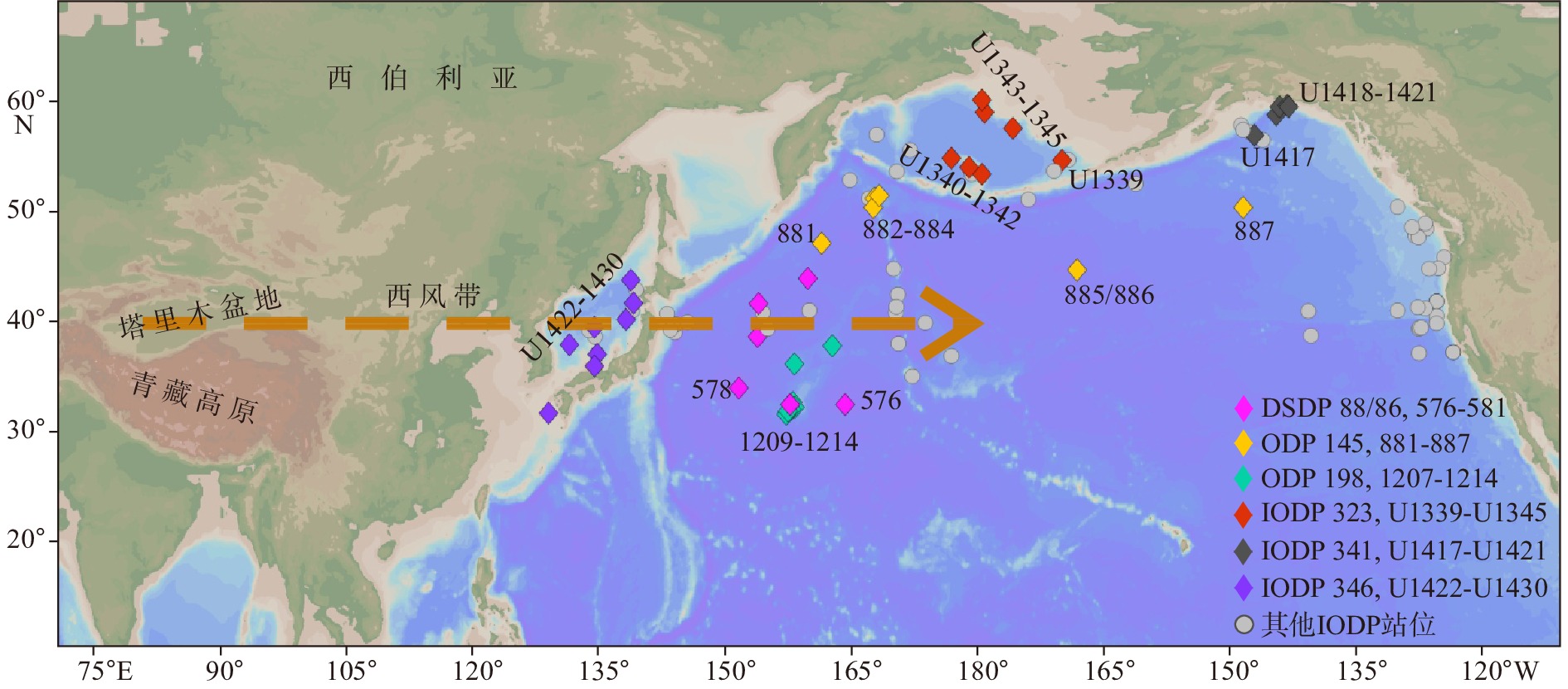
 下载:
下载:
